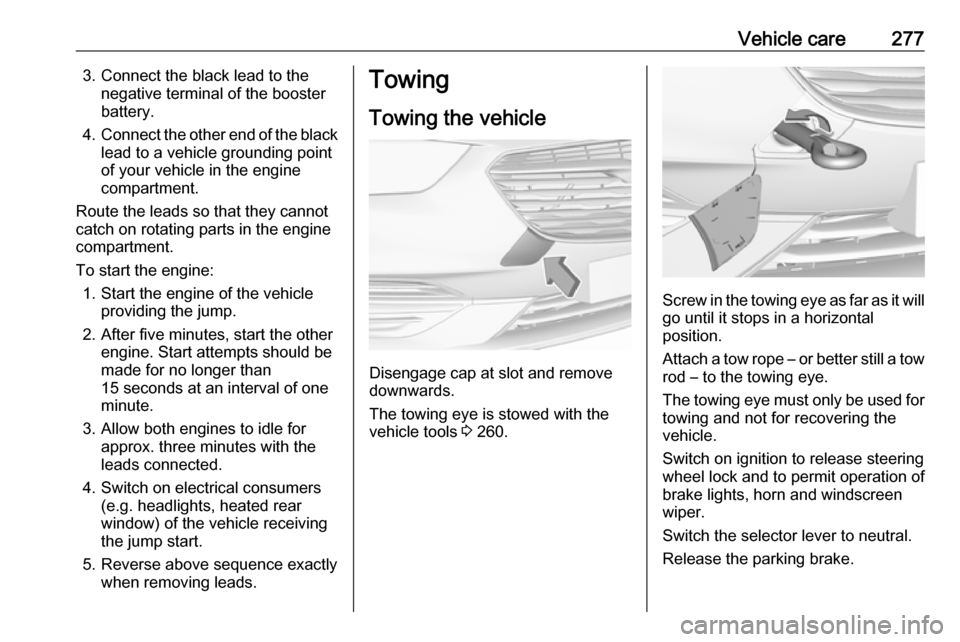stop start VAUXHALL INSIGNIA 2018 Owner's Guide
[x] Cancel search | Manufacturer: VAUXHALL, Model Year: 2018, Model line: INSIGNIA, Model: VAUXHALL INSIGNIA 2018Pages: 323, PDF Size: 9.25 MB
Page 245 of 323

Vehicle care243
The brake fluid level must be betweenthe MIN and MAX marks.
If fluid level is below MIN seek the
assistance of a workshop.
Brake and clutch fluid 3 283.
Vehicle battery
The vehicle battery is maintenance-
free provided that the driving profile
allows sufficient charging of the
battery. Short-distance-driving and
frequent engine starts can discharge
the battery. Avoid the use of
unnecessary electrical consumers.
Batteries do not belong in household
waste. They must be disposed of at
an appropriate recycling collection
point.
Laying up the vehicle for more than
four weeks can lead to battery
discharge. Disconnect the clamp from the negative terminal of the vehicle
battery.
Ensure the ignition is switched off
before connecting or disconnecting
the vehicle battery.
Battery discharge protection 3 146.
Disconnecting the battery
If the vehicle's battery is to be
disconnected (e.g. for maintenance
work), the alarm siren must be
deactivated as follows: Switch the ignition on then off, then disconnect
the vehicle's battery within
15 seconds.
Replacing the vehicle battery
Notice
Any deviation from the instructions
given in this section may lead to
temporary deactivation or
disturbance of the stop-start system.
When the vehicle battery is being
replaced, please ensure that there
are no open ventilation holes in the
vicinity of the positive terminal. If a
ventilation hole is open in this area, it
must be closed off with a dummy cap, and the ventilation in the vicinity of the
negative terminal must be opened.
We recommend that you have the
vehicle battery replaced by a
workshop.
Stop-start system 3 165.
Charging the vehicle battery9 Warning
On vehicles with stop-start
system, ensure that the charging potential does not exceed
Page 279 of 323

Vehicle care2773. Connect the black lead to thenegative terminal of the booster
battery.
4. Connect the other end of the black
lead to a vehicle grounding point
of your vehicle in the engine
compartment.
Route the leads so that they cannot
catch on rotating parts in the engine
compartment.
To start the engine: 1. Start the engine of the vehicle providing the jump.
2. After five minutes, start the other engine. Start attempts should be
made for no longer than
15 seconds at an interval of one
minute.
3. Allow both engines to idle for approx. three minutes with the
leads connected.
4. Switch on electrical consumers (e.g. headlights, heated rear
window) of the vehicle receiving
the jump start.
5. Reverse above sequence exactly when removing leads.Towing
Towing the vehicle
Disengage cap at slot and remove
downwards.
The towing eye is stowed with the
vehicle tools 3 260.
Screw in the towing eye as far as it will
go until it stops in a horizontal
position.
Attach a tow rope – or better still a tow
rod – to the towing eye.
The towing eye must only be used for towing and not for recovering the
vehicle.
Switch on ignition to release steering
wheel lock and to permit operation of
brake lights, horn and windscreen
wiper.
Switch the selector lever to neutral.
Release the parking brake.
Page 284 of 323

282Service and maintenanceService and
maintenanceGeneral information ...................282
Service information ..................282
Recommended fluids, lubricants
and parts .................................... 283
Recommended fluids and lubricants ................................ 283General information
Service information In order to ensure economical and
safe vehicle operation and to
maintain the value of your vehicle, it
is of vital importance that all
maintenance work is carried out at the proper intervals as specified.
The detailed, up-to-date service
schedule for your vehicle is available
at the workshop.
Service display 3 104.
European service intervals Maintenance of your vehicle is
required every 20,000 miles or after
1 year , whichever occurs first, unless
otherwise indicated in the service
display.
A shorter service interval can be valid for severe driving behaviour, e.g. for
taxis and police vehicles.
The European service intervals are
valid for the following countries:Andorra, Austria, Belgium, Bosnia-
Herzegovina, Bulgaria, Croatia,
Cyprus, Czech Republic, Denmark,
Estonia, Finland, France, Germany,
Greece, Greenland, Hungary,
Iceland, Ireland, Italy, Latvia,
Liechtenstein, Lithuania,
Luxembourg, Macedonia, Malta,
Monaco, Montenegro, Netherlands,
Norway, Poland, Portugal, Romania,
San Marino, Serbia, Slovakia,
Slovenia, Spain, Sweden,
Switzerland, United Kingdom.
Service display 3 104.
International service intervals
Maintenance of your vehicle is
required every 10,000 miles or after
1 year , whichever occurs first, unless
otherwise indicated in the service
display.
Severe operating conditions exist if
one or more of the following
circumstances occur frequently: Cold starting, stop and go operation, trailer
operation, mountain driving, driving
on poor and sandy road surfaces,
increased air pollution, presence of
airborne sand and high dust content,
Page 321 of 323

319Preheating ................................. 109
Puncture ..................................... 271
Q
Quickheat ................................... 157
R Radio Frequency Identification (RFID) ..................................... 314
REACH ....................................... 310
Reading lights ............................ 144
Rear cross traffic alert ................222
Rear floor storage cover ..............78
Rear fog light .....................111, 142
Rear seats .................................... 53
Rear storage ................................. 78
Rear view camera ...................... 220
Rear window wiper/washer .......... 90
Recommended fluids and lubricants ........................ 283, 288
Refuelling ................................... 231
Registered trademarks ...............313
Retained power off .....................163
Reversing lights .........................143
Ride control systems ..................181
Roof .............................................. 41
Roof load ...................................... 84
Roof rack ..................................... 83S
Safety belts ................................... 54
Safety net .................................... 79
Seat adjustment ............................. 6 Seat belt ........................................ 8
Seat belt reminder .....................105
Seat belts ..................................... 54
Seat heating Seat heating, front .....................52
Seat heating, rear .....................53
Seat position ................................ 45
Selective catalytic reduction .......170
Service ............................... 159, 282
Service display .......................... 104
Service information ....................282
Side airbag system ......................60
Side blind zone assistant ............214
Sidelights .................................... 134
Side turn signal lights ................254
Software acknowledgement .......311
Software update ......................... 312
Spare wheel ............................... 274
Speed limiter....................... 111, 188
Speedometer ............................. 101
Starting and operating ................161
Starting off ................................... 17
Starting the engine ....................163
Steering ...................................... 161
Steering wheel adjustment ......9, 87
Steering wheel controls ...............87Stop-start system........................ 165
Storage ......................................... 71
Storage compartments .................71
Sunglasses storage .....................72
Sunroof ........................................ 41
Sunvisor lights ........................... 145
Sun visors .................................... 41
Symbols ......................................... 4
T Tachometer ............................... 103
Tail lights ................................... 249
Three-point seat belt .................... 55
Tools .......................................... 260
Tow bar....................................... 233
Towing ................................ 233, 277
Towing another vehicle .............278
Towing equipment .....................235
Towing hitch installation dimensions ............................. 304
Towing the vehicle .....................277
Traction Control system ............. 181
Traction Control system off......... 109
Traffic sign assistant ...........111, 223
Trailer coupling ........................... 233
Trailer stability assist .................236
Trailer towing ............................. 234
Transmission ............................... 16
Tread depth ............................... 265
Trip odometer ............................ 102